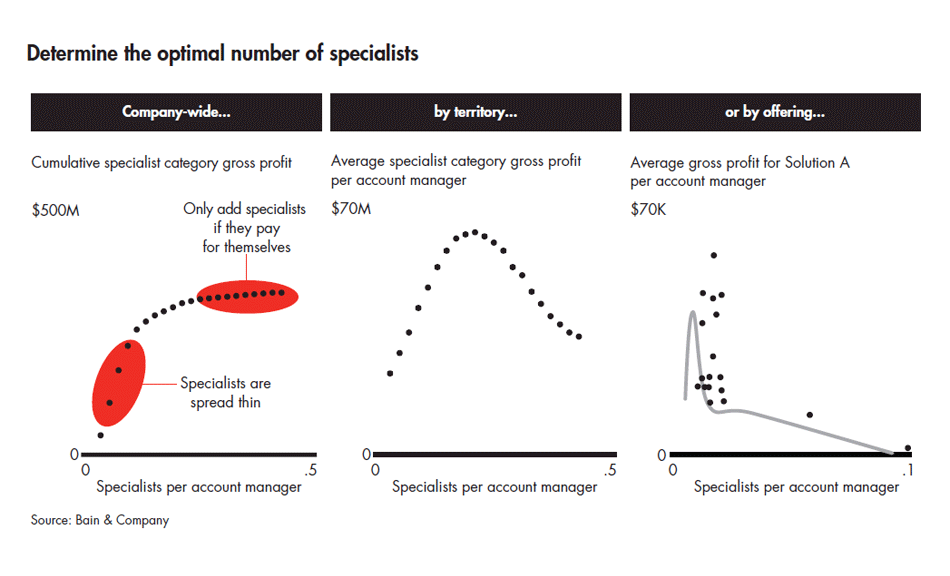Why You Should Never Underestimate the Fine Art of Sales Support
Carolyn Chassaigne
Whether it’s a sales engineer, strategist, or CEO, having the right person in the right place at the right time is key to winning new business.
The ROI of Getting It Right
Figuring out who needs to be a part of the meeting is often a last minute endeavor. How many times have you been in a meeting and heard, “well, Jill’s actually the one that does that, but she’s not here”?
While some complexity unavoidable, this last minute shuffle does nothing to bolster customer confidence and undermines your own credibility. It could even cost you the deal.
Bain and Company analyzed various sales models in a recent piece, touching on the the importance of matching up resources.
We recently sat in on a technology provider’s sales call with the CIO of a prospective customer, during which several product engineering specialists debated how to configure a solution. Prior to the key meeting, no one had led a process to sort out the different expert points of view so that the supplier could present a coherent case. The CIO was not impressed.”
One way to quantify the value of finding the right person is to quantify what might be lost without them. Bain studied sales specialists for a particular distributor using “counterfactual analysis” to peg the costs of hiring, compensating and integrating those sales specialists into the organization. They weighed the cost against the value of the role, essentially the amount of profitable revenue a company would lose without that person.
Bain found that specialists contributed a gross profit of $236 million at a compensation cost of $20 million which nets out $216 million or an ROI of more than 1,000%. Now granted, your scale might be different, but the takeaway is clear: domain expertise is valuable.
Make it a point to match up the right talent in your organization with the stakeholders you’re pitching. Look at an organization’s structure and decide whether someone from services, support, or marketing should tag along. But don’t do it for a show of force. Every person should have a specific role. It doesn’t have to be scripted, just play out the questions they should be prepared to address.
Integrate People and Processes
After the pitch team is in place, lean on colleagues to help you connect the bigger picture. A talented strategist can help you size up the industry and identify trends. Press them on who they worked with, what they learned, and how an industry or internal challenge was overcome.
A colleague in professional services is a great person to ask about service delivery, development, or even pricing for the right industry. Often, they’ve been in many of the situations you’re selling into. Give them insight on your client’s service model and product and ask for a quick take on typical challenges. While the industry or model might be different, an agile methodology is usually pretty similar across verticals.
A study in Harvard Business Review on sales and marketing highlighted the importance of “integration.”
The best examples of integration we found were in companies that already emphasized shared responsibility and disciplined planning; that were metrics driven; that tied rewards to results; and that were managed through systems and processes.”
The Medium and The Message
Now that you’re prepped, don’t blow it with bullet points and what you think is a whiz-bang WebEx. Think about which medium is best suited for delivering your message and break it down into digestible increments. This is where data become your best sales support.
But don’t just package your own stuff, pull together some data about your customer’s industry and draw some conclusions for them. Where’s the industry headed? How will you help them get there? Your clients are already drowning in information. Help them cut through the clutter and you’ll get invited back.
Your goal is to create relevant touch points without playing your hand too early. Too often we think of the presentation as a single occurrence or rigid point in time. It should be something that’s more fluid, an entity that changes as the dialogue changes.
When I worked as a strategist, I called it “selling on the periphery.” I wasn’t always in direct sales mode with reps, but I was always chipping away at the opportunity. Those conversations were all presentations with specific objectives attached to each one.
Orchestration and Timing
The artistry of sales support often comes to life around orchestration and timing. One of the best sales engineers I worked with was a master at facilitation. He could sense when it was the right time to defer to an online presentation, push for a pilot, or to eat some margin to get a chance at the larger opportunity. When you think about your best facilitators, it’s not all about the who.
Think about where your customer is in the cycle of business. Are they a startup poised to launch something new? Are they an incumbent leader in their segment? Those distinctions should be your criteria when reaching out for sales support. It also clears up confusion and eliminates unnecessary resources.
If you’re pitching to startups and your CEO is a serial entrepreneur, he’ll probably do fine on the call. Remember that people like to interact with other peers in their profession. They’re usually the ones that best relate to the “pain.” So be a matchmaker, step back, and orchestrate the touchpoints. You’ll be surprised how much you can gain from just knowing which people should be talking. That’s low-pressure selling with a high return.
Get sales tips and strategies delivered straight to your inbox.
Yesware will help you generate more sales right from your inbox. Try our Outlook add-on or Gmail Chrome extension for free, forever!
Related Articles
Melissa Williams
Melissa Williams
Casey O'Connor
Sales, deal management, and communication tips for your inbox


